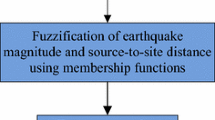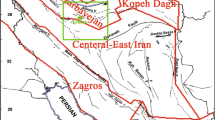Abstract
This paper presents an outline of a risk assessment system for evaluating the expected damage of structures and the consequent financial losses and casualties due to a likely earthquake under elevated uncertain conditions; namely where neither the statistical data nor the seismological and engineering knowledge required for such evaluations are sufficient. In such cases, we should consider extra dimensions of uncertainty, in addition to probability that is usually sufficient for expressing the risk of losses and casualties due to an earthquake where such knowledge and data is available. In the present paper, the uncertainties caused by the insufficient knowledge about the interdependency of various parameters have been considered by means of fuzzy relations. Moreover, the uncertainties in eliciting the likelihood of the seismic hazard have been expressed by fuzzy probability in the form of possibility-probability distributions (PPDs). In other words, fuzzy set theory is employed to complement the standard probability theory with a second dimension of uncertainty. By composition of the fuzzy probability of the seismic hazard and fuzzy vulnerability relation of target structure, the fuzzy probability of damage can be derived. The proposed approach has also been compared with an alternative approach for obtaining a PPD of the hazard. As a case study, the risk assessment system has been tested on a sample structure in the Istanbul metropolitan area.
Similar content being viewed by others
References
American Red Cross-Turkish Red Crescent (2002) Earthquake risk assessment for istanbul metropolitan area, Boğazi çi University, Turkey
Boore D, Joyner W, Fumal T (1997) Equations for estimating horizontal response spectra and peak acceleration from Western North American earthquakes: a summary of recent work. Seismol Res Lett 68(1):128–153
Cooman G, Ruan D, Kerre E (eds) (1995) Advances in fuzzy systems, vol 8. World Scientific, Singapore
Dempster A (1967) Upper and lower probabilities generated by a random closed interval. Annu Math Stat 38:325–339
Dubois D, Prade H (1998) Possibility theory. Plenum, New York
Dubois D, Prade H, Smets Ph (2001) New semantics for quantitative possibility theory. In: 2nd international symposium on imprecise probabilities and their applications, Ithaca, New York
FEMA 273 (1997) NEHRP guidelines for the seismic rehabilitation of buildings. Federal Emergency Management Agency, Washington, DC
HAZUS® MH Technical Manual (2003) Multi-hazard loss estimation methodology, earthquake model. Federal Emergency Management Agency, Washington, DC
Huang C, Moraga C (2002) A fuzzy risk model and its matrix algorithm. Int J Uncertain Fuzziness Knowl -Based Syst 4:347–362
Karimi I, Hüllermeier E, Meskouris K (2004) An earthquake risk assessment method based on fuzzy probability. In: Applied computational intelligence. World Scientific, pp 376–381
http:// yorku.ca/esse/veo/earth/sub1-10.htm
Lucas C, Araabi B (1999) Generalization of the Dempster–Shafer theory: a fuzzy-valued measure. IEEE Trans Fuzzy Syst 7:255–270
Möller B, Beer M (2003) Fuzzy randomness. Springer, Berlin Heidelberg New York
Shafer G (1976) A mathematical theory of evidence. Princeton University Press, New York
Tanaka H, Fan C, Lai F, Toguchi K (1983) Fault tree analysis by fuzzy probability. IEEE Trans Reliab R-32(5):453–457
Wolkenhauer O (1998) Possibility theory with applications to data analysis. Research Studies Press Ltd., UK
Zimmermann HJ (1996) Fuzzy sets theory and its applications, 3rd edn. Kluwer, Dordrecht
Author information
Authors and Affiliations
Corresponding author
Rights and permissions
About this article
Cite this article
Karimi, I., Hüllermeier, E. & Meskouris, K. A fuzzy-probabilistic earthquake risk assessment system. Soft Comput 11, 229–238 (2007). https://doi.org/10.1007/s00500-006-0063-9
Published:
Issue Date:
DOI: https://doi.org/10.1007/s00500-006-0063-9




